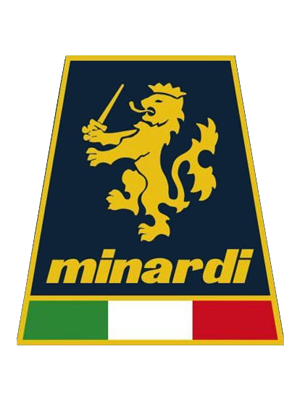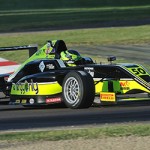From beating metal sheets to rapid prototyping: the evolution of Formula 1
While days run by and we get quickly to the second session of collective winters test at the Spanish track of Barcelona, we have met Gian Carlo Minardi at his Headquarters in Faenza (and could not be elsewhere).
Although he had left behind the nr. 21 in Via Lazzaro Spallanzani (Faenza) – Headquarters of his Minardi Team since 1984 – with his going out from the Formula 1 World Championship, in the new office it continues to breathe the air of Formula 1, through the helmets of the many drivers who have worn the yellow-blue colours, through the cars’ wheels, the models and the Cosworth F1 – TJ 2005 10V engine, used as coffee table. The eye focuses on a photo album that we readily open. The mind begins to travel quickly back in time, as if we had the DeLorean of “Doc” Emmett Brown and Marty McFly. There are photographs that seem prehistoric times, but that are part of the history of Italian Formula 1 World Championship. Today we are used to hearing about the wind tunnel, the latest generation of simulators, able to reproduce reality, but it was not always this way. “Having a look to these photographs, you have the impression that a century has passed. But we talk about only 30 years ago“, Gian Carlo Minardi says.
 Our travel begins from the years ’84 -’85. “It’s amazing how the world has changed, without realizing it, and the great strides made by technology. But let’s also ask questions. Is all this necessary? Let me explain. In the ‘80es to build two Formula 1 cars 22-23 people were employed. The technical office was a room of 26 square meters. Today, despite the help of technology, teams are more than 400 employees. Certainly cars and aerodynamics are more complex, but, still giving space to the evolution, I think we have reached incredible levels of staff“, the former Team Principal continues.
Our travel begins from the years ’84 -’85. “It’s amazing how the world has changed, without realizing it, and the great strides made by technology. But let’s also ask questions. Is all this necessary? Let me explain. In the ‘80es to build two Formula 1 cars 22-23 people were employed. The technical office was a room of 26 square meters. Today, despite the help of technology, teams are more than 400 employees. Certainly cars and aerodynamics are more complex, but, still giving space to the evolution, I think we have reached incredible levels of staff“, the former Team Principal continues.  “In 1984, the chassis were built with composite materials, in particular Carbon fiber and Kevlar and the bodywork was created manually, as all the equipment for its realization (models), using materials for easily workable modeling. The required geometries were obtained manually. The difficulty was to do equal left and right sidepod. The cars were really handmade. It was also very frequent to produce parts or bodywork components, such as the closing element of dampers compartment, obtained in metal sheets molded by hand from the trusty Otello, historic Ferrari bodywork builder of the late ‘60s. So, until the early ’80s, each piece was handmade, before taking it in the wind tunnel“.
“In 1984, the chassis were built with composite materials, in particular Carbon fiber and Kevlar and the bodywork was created manually, as all the equipment for its realization (models), using materials for easily workable modeling. The required geometries were obtained manually. The difficulty was to do equal left and right sidepod. The cars were really handmade. It was also very frequent to produce parts or bodywork components, such as the closing element of dampers compartment, obtained in metal sheets molded by hand from the trusty Otello, historic Ferrari bodywork builder of the late ‘60s. So, until the early ’80s, each piece was handmade, before taking it in the wind tunnel“.
 The next step was the introduction of computers and, subsequently, of 3D modeling. “In 1988 he made his entrance in the Headquaters the FTP machine with three-axis nurmerical control. Once made the drawing, you could see the car growing. This machine was followed by the “JOBS“, a machine tool with the control on five axes that allowed to realize the full shape of the body, shaping a block of resin through the mathematical calculation of the external surfaces, produced by CAD designers. This first model was used to obtain the mold on which realize the car chassis made of carbon.
The next step was the introduction of computers and, subsequently, of 3D modeling. “In 1988 he made his entrance in the Headquaters the FTP machine with three-axis nurmerical control. Once made the drawing, you could see the car growing. This machine was followed by the “JOBS“, a machine tool with the control on five axes that allowed to realize the full shape of the body, shaping a block of resin through the mathematical calculation of the external surfaces, produced by CAD designers. This first model was used to obtain the mold on which realize the car chassis made of carbon.
 The real revolution arrives in the 2000s, when it starts to use the machines for rapid prototyping, or stereolithography.
The real revolution arrives in the 2000s, when it starts to use the machines for rapid prototyping, or stereolithography.
Through the solidification by laser of a liquid resin, you obtained very useful “finished” elements, especially for creating the components necessary for aerodynamic tests in the wind tunnel. Technology that has allowed to speed up the production of these components“.
 Rapid prototyping comes in Faenza. “Minardi was among the first companies to have this technology, certainly the first in F1 to install a 3D Systems SLA® 7000, a step followed shortly by some top teams. Made the first study with Cad tecnologies, the first model on ½ scale was built, in order to go in the wind tunnel“.
Rapid prototyping comes in Faenza. “Minardi was among the first companies to have this technology, certainly the first in F1 to install a 3D Systems SLA® 7000, a step followed shortly by some top teams. Made the first study with Cad tecnologies, the first model on ½ scale was built, in order to go in the wind tunnel“.
 Finally, a nice as unpublished gem. “Here is the model of the Minardi 2006, which unfortunately never saw the light. It is the last creature of Eng. Gabriele Tredozi. We were already ahead in the design of the body“, Gian Carlo Minardi says, concluding the story,” when in September 2005 began negotiations with Red Bull for the transfer of ownership“.
Finally, a nice as unpublished gem. “Here is the model of the Minardi 2006, which unfortunately never saw the light. It is the last creature of Eng. Gabriele Tredozi. We were already ahead in the design of the body“, Gian Carlo Minardi says, concluding the story,” when in September 2005 began negotiations with Red Bull for the transfer of ownership“.
 A special thanks to Eng. Gabriele Tredozi for the invaluable technical support. On our official FaceBook , there is a wide gallery with more photos also of the Minardi PS06.
A special thanks to Eng. Gabriele Tredozi for the invaluable technical support. On our official FaceBook , there is a wide gallery with more photos also of the Minardi PS06.

